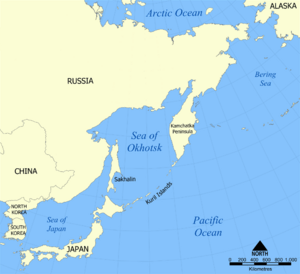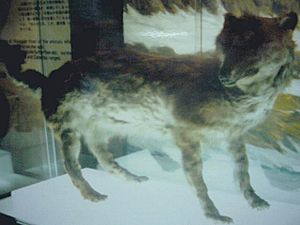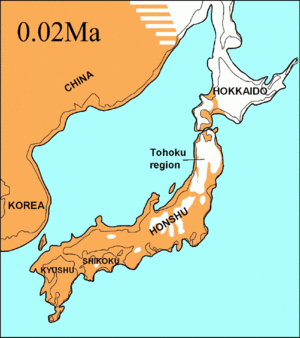Hokkaido wolf facts for kids
Quick facts for kids Canis lupus hattai |
|
|---|---|
 |
|
| Taxidermied Ezo wolf at Hokkaido University Museum | |
| Conservation status | |
| Scientific classification |
|
| Kingdom: | Animalia |
| Phylum: | Chordata |
| Class: | Mammalia |
| Order: | Carnivora |
| Family: | Canidae |
| Genus: | Canis |
| Species: | |
| Subspecies: |
†C. l. hattai
|
| Trinomial name | |
| Canis lupus hattai Kishida, 1931
|
|
 |
|
| Range included Hokkaido and Sakhalin islands, the Kamchatka Peninsula and Iturup and Kunashir islands just to the east of Hokkaido in the Kuril archipelago. | |
| Synonyms | |
|
C. l. rex (Pocock, 1935) |
|
The Hokkaido wolf (Canis lupus hattai), also known as the Ezo wolf (Japanese: エゾオオカミ(蝦夷狼)ー, Hepburn: Ezo Ōkami), was a type of gray wolf that once lived in parts of coastal northeast Asia. In Russia, it was sometimes called the Sakhalin wolf. Interestingly, its closest relatives were wolves from North America, not other Asian wolves.
This wolf became extinct in Hokkaido around 1889. This happened during a time when Japan was modernizing its farming practices, using methods from America. These methods included using special baits to protect farm animals from predators.
Some experts believe that a few Hokkaido wolves might have survived on Sakhalin island until about 1945. The Hokkaido wolf was one of two types of wolves that lived in the Japanese archipelago; the other was the Japanese wolf (C. l. hodophilax).
Contents
Discovering the Hokkaido Wolf's Family Tree
The Hokkaido wolf, scientifically known as Canis lupus hattai, was a unique kind of gray wolf. Scientists call it a "subspecies" because it was a specific group within the larger gray wolf family.
In the late 1800s, researchers compared the skulls of wolves from Hokkaido with those of the Japanese wolf. They noticed clear differences, suggesting they were distinct types. In 1931, a scientist named Kishida Kyukishi officially described the Hokkaido wolf as its own subspecies.
How Scientists Traced Its Ancestry
Modern science, using DNA analysis, helped us learn even more. By studying the DNA from Hokkaido wolf remains, scientists found something surprising. The Hokkaido wolf's DNA was very similar to that of wolves found in North America, like those in Canada and Alaska. This means their ancestors were closely related!
Scientists believe that the Hokkaido wolf's ancestors traveled to Japan from North America. This journey likely happened over a land bridge that connected Sakhalin Island to the mainland about 10,000 years ago. This was after the last Ice Age. The narrow Tsugaru Strait prevented them from reaching Japan's main island, Honshu.
What Did the Hokkaido Wolf Eat
Scientists can also learn about an animal's diet by studying its bones. By analyzing the bones of Hokkaido wolves, researchers discovered their eating habits. These wolves ate both land animals and marine creatures. This diet was similar to that of some modern wolves living along the coast of British Columbia today.
Where the Hokkaido Wolf Lived
The word "Ezo" is an old Japanese term meaning "foreigner." It referred to the lands where the Ainu people lived, north of Japan's main island, Honshu. These lands included Hokkaido, Sakhalin, the Kuril Islands, and even the Kamchatka Peninsula.
The Hokkaido wolf made its home across these areas. It lived on Hokkaido and Sakhalin islands. It also inhabited Iturup and Kunashir islands, which are part of the Kuril archipelago, and the Kamchatka Peninsula.
Sadly, the Hokkaido wolf disappeared from Hokkaido island in 1889. There were some reports that it might have survived on Sakhalin and the Kuril Islands until 1945. However, these reports are uncertain. Some experts believe that any wolves seen on Sakhalin after the early 1900s were likely other types of wolves passing through. Surveys in the 1960s found no wolves on the Kuril Islands, only many wild dogs.
What Did the Hokkaido Wolf Look Like?
The Hokkaido wolf was a large and powerful animal. It was similar in size to other gray wolves found in Asia and North America. It stood about 70–80 centimeters (27–31 inches) tall at its shoulders.
Its fur was typically light gray, with darker hairs running along its back. In winter, its fur would become thicker and longer, turning a grayish-white color.
An observer named Edwin Dun described these wolves as formidable, meaning impressive and strong. He noted they were not usually dangerous to humans if they had other food. They were lean but very muscular. Their heads and mouths were large, with strong fangs and teeth.
Special Adaptations for Hunting
One remarkable feature of the Hokkaido wolf was its large feet. They were much bigger than those of even the largest dogs. These big feet helped them move quickly over deep snow. This was a great advantage when hunting deer, which would get tired in the snow.
Hokkaido wolves often hunted alone or in pairs. However, sometimes their tracks in the snow showed that larger groups, or packs, of four or five wolves, or even more, hunted together.
The Hokkaido Wolf's Story
The Wolf in Ainu Culture
The Ainu people, who are the indigenous people of Hokkaido and surrounding regions, deeply respected the Hokkaido wolf. They called it Horkew Kamuy, which means "howling god." They saw the wolf as a powerful hunter, much like themselves.
The Ainu had special ceremonies where they honored wolves. Some Ainu stories even linked the creation of their people to a white wolf and a goddess. Ainu hunters would often leave parts of their hunted animals for wolves. They believed they could even share a wolf's kill if they showed respect.
Because of this special connection, Ainu hunters had strict rules. They were not allowed to kill wolves with poisoned arrows or guns. Wasting a wolf's fur or meat was also forbidden, as it was thought to anger the wolves. The Ainu also saw wolves as very similar to their own dogs. They sometimes allowed their dogs to breed with wolves, hoping to create stronger, more wolf-like offspring.
Why the Hokkaido Wolf Disappeared
The Hokkaido wolf became extinct on Hokkaido island around 1889. This sad event was linked to big changes happening in Japan. In 1868, the Meiji Restoration began. Emperor Meiji wanted to modernize Japan and opened the country to new ideas.
One major change was in farming. Japan wanted to move away from relying only on rice. They started adopting American-style ranching, which involved raising livestock like horses and cattle. To do this, the government encouraged people to settle and develop the island of Hokkaido.
Protecting Livestock and the Wolf's Fate
However, the Hokkaido wolves hunted these new farm animals, especially horses. To protect the livestock, the government decided the wolves were "harmful animals." In 1873, an American rancher named Edwin Dun was hired to help. He introduced methods to get rid of the wolves.
These methods included using special baits designed to kill predators. The government also offered rewards, called bounties, to people who killed wolves. These efforts, aimed at protecting the new ranches, unfortunately led to the complete disappearance of the Hokkaido wolf.
See also
 In Spanish: Lobo de Ezo para niños
In Spanish: Lobo de Ezo para niños




